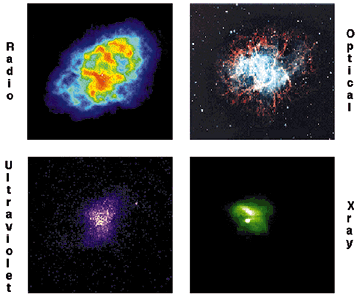Images - Size, Resolution, and Focus
"An image is an optical representation of an object produced by light
rays from the object being refracted or reflected by a lens or mirror."
- George Abell in Exploration of the Universe.
"An optically formed duplicate, counterpart, or other representative
reproduction of an object, especially an optical reproduction of an object
formed by a lens or mirror." - American Heritage Dictionary.
|
| This is an image of a Dalmatian. |
|
| This is an image of a galaxy. |
Both of these
imageshave one thing
in common: They are optical
light
images. This is what the objects look like with our eyes (or at least with our
telescope-aided eyes). But an image can be made out of any kind of
electromagnetic
radiation. You just have to have the right kind of detector to 'see' the
kind of radiation you want to study. For example, if I want to make an
X-ray image of my
hand, I can put a piece of X-ray sensitive film under my hand and shoot X-rays
into the top of my hand. What I get is an X-ray image of my hand that my eyes
can interpret. What I see is not what my hand looks like to my eyes, but what
my hand would look like if instead of light my eyes could see X-rays! We do
the same thing with
stars and galaxies
and such. We use a detector that can see the X-rays they emit and then, in a
very clever way, interpret what we have measured so that we can produce an
'image' of what the objects would look like if our eyes could see X-rays.
An image is just a way for scientists to plot things or draw things so
that they can look at them. Most images show the brightness of an object in
the spatial domain, i.e. how many photons are coming from a specific
location in space. The ability of a detector to tell one location from a
nearby location is called
spatial
resolution. Three properties of an image-- size, resolution, and
brightness-- are the most important properties of an image to a scientist.
From size, we learn about astronomical scales--- like how big is the Moon.
From brightness, we learn the amount of energy that an object is
producing and then we may be able to figure out HOW it is producing that
energy. Finally, the resolution lets us know things like whether or not
a planet has rings or if there are two stars close to each other versus one
star by itself.
Looking at images of the same object made with different parts of the
electromagnetic
spectrum is a very important tool for scientists. They can learn
something unique about the object at every different
wavelength,
and then they can figure out "the big picture" of what is really
going on with that object by putting what they learn from each wavelength
together into a model that can explain everything they see! For example, in
the figure below, we see four images of the Crab Nebula. The
radio image tells us
about the
magnetic
fields and free electrons in the Nebula. The optical image tells us
about the hydrogen in the Nebula and more about the free electrons moving in
the magnetic field of the
pulsar. The UV
image tells us about the cooler electrons, while the X-ray image tells us
about the very hot electrons which are clearly coming from the collapsed
central object in the Nebula.

|
